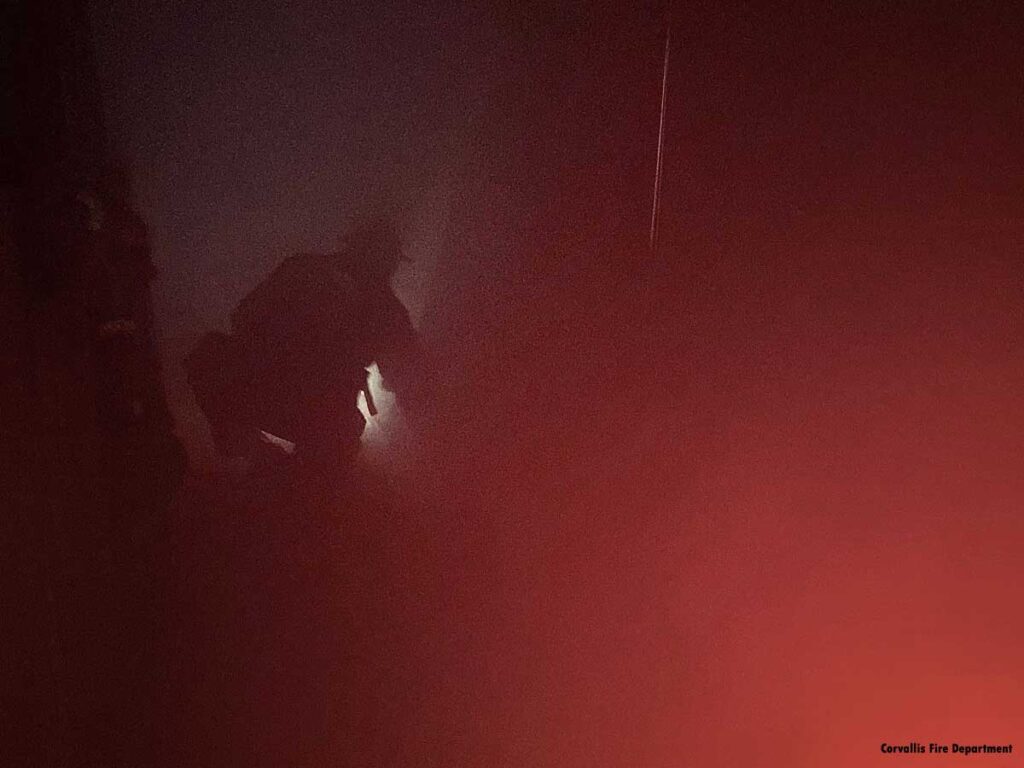
By Brett Loomis
Sunday is drill day for firefighters in Corvallis, Oregon. Every Sunday, all on-duty resources go to the tower for the drill of choice. Today it was, ironically, first-alarm drills…back to the basics. It is mid-October so the sun was out, the sky is blue, and it is a great day to train. Then come the tones.
It’s a residential structure fire on Northwest Thistle Place. About a five-minute drive from the tower. We just parked! Didn’t even make it to the classroom for briefing. We turned out with a little more spring in our step (we all move a hint faster when it’s a fire). We are on the road to the fire.
- Handling the Mayday: The Fire Dispatcher’s Crucial Role
- Getting Critical Dispatch Information
- Understanding Emergency Communications
- Communications Broke Down: An Excuse for a Serious Problem
While we are responding, dispatch advises that the reporting party is trapped in her back bedroom and can’t get out. A confirmed victim profile. Everyone responding knows the statistics: 80% of confirmed victims are reported to responding units by dispatch. We were saving a life today.
Allison is a veteran dispatcher with 10 years on the job. Like most of the dispatch centers in the United States, law enforcement dispatch is their primary function. Fire and EMS are secondary. Ours is no different. Allison was working Fire today. Just six months ago, I facilitated training with all our dispatchers. One of the key points that was shared is that a structure fire is an in-progress call for firefighters just like a robbery is an in-progress call for police. They need to keep the reporting party on the phone and get as much detail as possible. We discussed, in detail, victim profiling. We also trained to “Get the SIGNAL,” that is: Species, Incapacity, Gender, Number, Age, Location. Allison did!
Now, prior to arrival, we know there is an adult female, conscious and breathing, the sole human occupant of the home, in the right rear bedroom (C/D corner). We also know that there was a dog with the trapped occupant. Allison even got directions to the bedroom from the front door. “Through the front door, immediate right, then left to the door at the end of the hallway” to the C/D bedroom where the victim had retreated.
We have every bit of information we need to make a successful grab today!
Our battalion chiefs monitor police radio traffic to get as much intelligence and situational awareness that we can. Police arrived and reported heavy smoke coming from the building. We have done a good job of educating our police officers about not creating flow paths. They didn’t create one on this fire.
I am a block away with a visual on the smoke with three engines, a truck, and two medic units behind me. That’s when I heard over the radio that police officers found the victim in her backyard. Self-extricated through a window with her dog. They are requesting medics for smoke exposure. That information doesn’t change our posture at all. Our victim profile might have changed, but our mission didn’t. Protect LIFE and PROPERTY.
- Tactical Supervision for Known Rescues
- Civilian Rescue: The Reason We Exist
- On-Scene Cooperation: Fire Department and Law Enforcement
The house was a one-story, single-family legacy home at about 1,800 square feet. There was dark, pressurized smoke from the eaves and out of the chimney. Arrival report…check! Size-up with a 360…check! Assignments as follows: BC117 – Command; E133 – initiate fire attack; M120 – Initiate two-out; E131 – bring in water and assume Division Alpha objectives are attack, search, and two-out with 133, 131, and 120; E132 (quint) – assume roof division with the objective of performing vertical ventilation; M125 – Initiate medical the occupant is on the A side; E136 – forward staging. Just as quickly as the assignments were made, we had a knock on the fire, a primary search complete, and medical care being provided for the formerly trapped occupant. A great incident built on a solid foundation that was set by our dispatcher.
I called Allison to thank her for the success of that call. She told me that was the first time in her 10 years that she had taken a call from a person that was trapped in a fire. She said she would have never thought to ask those questions until she had the training. She’s a good dispatcher and I think she would have gotten plenty of information without the training, but getting the validation sure helped.
A major component of the NIOSH 5 is lack of, or failure of, communications. There are so many components to the communications issue that can impact our incident. Discovery of the fire, the time and method of reporting, the ability of dispatch to get accurate information, call processing time, accurate relay of information, conflicting information on scene, crowded radio traffic, and misunderstood assignments can all put your incident out of alignment. Don’t let it!
Understand your entire system before your incident. Know how your computer aided dispatch works. Know how your radio system works. Establish relationships with your dispatchers. Train with your dispatchers. Practice your communications early and often. Calm, clear, and concise radio traffic comes from training.
We don’t have to think about donning your turnouts or your self-contained breathing apparatus. It’s second nature. If communications are one of the major reasons for civilian and firefighter fatalities, shouldn’t it be second nature, too?
BRETT LOOMIS is a battalion chief with the Corvallis (OR) Fire Department. He has more than 30 years of experience in the fire and emergency services.

